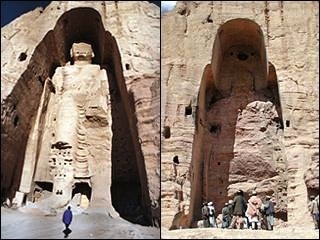Islam Bulldozes the Past

ISIS blew up Shi'ite mosques in Mosul in 2014.
|
Worse, the ISIS record fits into an old and common pattern of destruction of historical artifacts by Muslims.
Some attacks target the works of other, rival religions, such as Orthodox churches in northern Cyprus (since 1974), the Bamiyan Buddhas in Afghanistan (in 2001), the Ghriba synagogue in Tunisia (2002), an historic Hindu temple in Malaysia (2006), and the Assyrian antiquities ("idols") in Mosul (2015). On a personal level, a Saudi national smashed historic statues at the Senso-Ji Buddhist temple in Tokyo in 2014. Nor is this danger over: Islamic leaders have bruited plans to destroy Persepolis in Iran, St. Catherine's Monastery in the Sinai, and the Great Pyramids of Egypt.
All other major religions have moved beyond such crudely violent impulses.
|
Muslims of one denomination sometimes destroy the legacy of other Islamic sects. Recent examples include the tomb of Sidi Mahmoudou, a medieval structure in Timbuktu (2012), Sufi tombs in Libya (2012), and the libraries of Mosul (2015). But best known is the Saudi destruction of antiquities in Mecca since the 1990s, applying strict Wahhabi principles of non-intercession; even Muhammad's tomb in Medina is in jeopardy.

The Taliban blew up a monumental sixth-century Buddha statue in 2001.
|
Ancient artifacts might even be demolished because their space is needed for something deemed urgent. The Palestinian Authority threw out precious Temple Mount archeological remains as mere rubble in 2000 to build a mosque. In 2013, Hamas bulldozed part of the 3,000-year-old Anthedon Harbor in Gaza for military purposes and the Turkish authorities damaged the Byzantine-era walls of the Yedikule Gardens to build a decorative pool.
Finally, there are gratuitously self-inflicted cultural wounds. These include the pillaging of Iraqi museums, libraries, and archives (2003), the burning in 2011 of L'Institut d'Égypte and looting of the Egyptian Museum, the 2013 destruction of manuscripts in Timbuktu and the ransacking of the Mallawi Museum in Minya, Egypt, and the 2014 destruction at the Saeh Library in Tripoli, Lebanon and at the Museum of Islamic Art in Cairo.

Al-Qaeda bombed the Ghriba Synagogue in Tunisia in 2002.
|
While the seizure and appropriation of other monuments began at the very inception of Islam (i.e., the Kaaba), the destruction that has reached orgiastic heights with ISIS is something new; note that nearly all the examples listed here date from the twenty-first century. Turned around, those recently-destroyed antiquities survived so long because Muslims had left them alone. In this regard, things are far worse these days than ever before – not a surprise, as Islam is in its worst shape ever. All other major religions have moved beyond such crudely violent impulses whose motive is unacceptable and whose results are tragic.
Is there a Middle Eastern country that exults in its multi-religious heritage, celebrates ancient artifacts on coins and stamps, builds fabulous museums for its antiquities, treats archeology as a national pastime, and studies manuscripts rather than burns them? Well, yes, there is. It's called Israel. The rest of the region could learn a thing or two about historical appreciation from the Jewish state.
Daniel Pipes (DanielPipes.org, @DanielPipes) is president of the Middle East Forum.
Labels: Atrocities, Heritage, Islamic State

<< Home